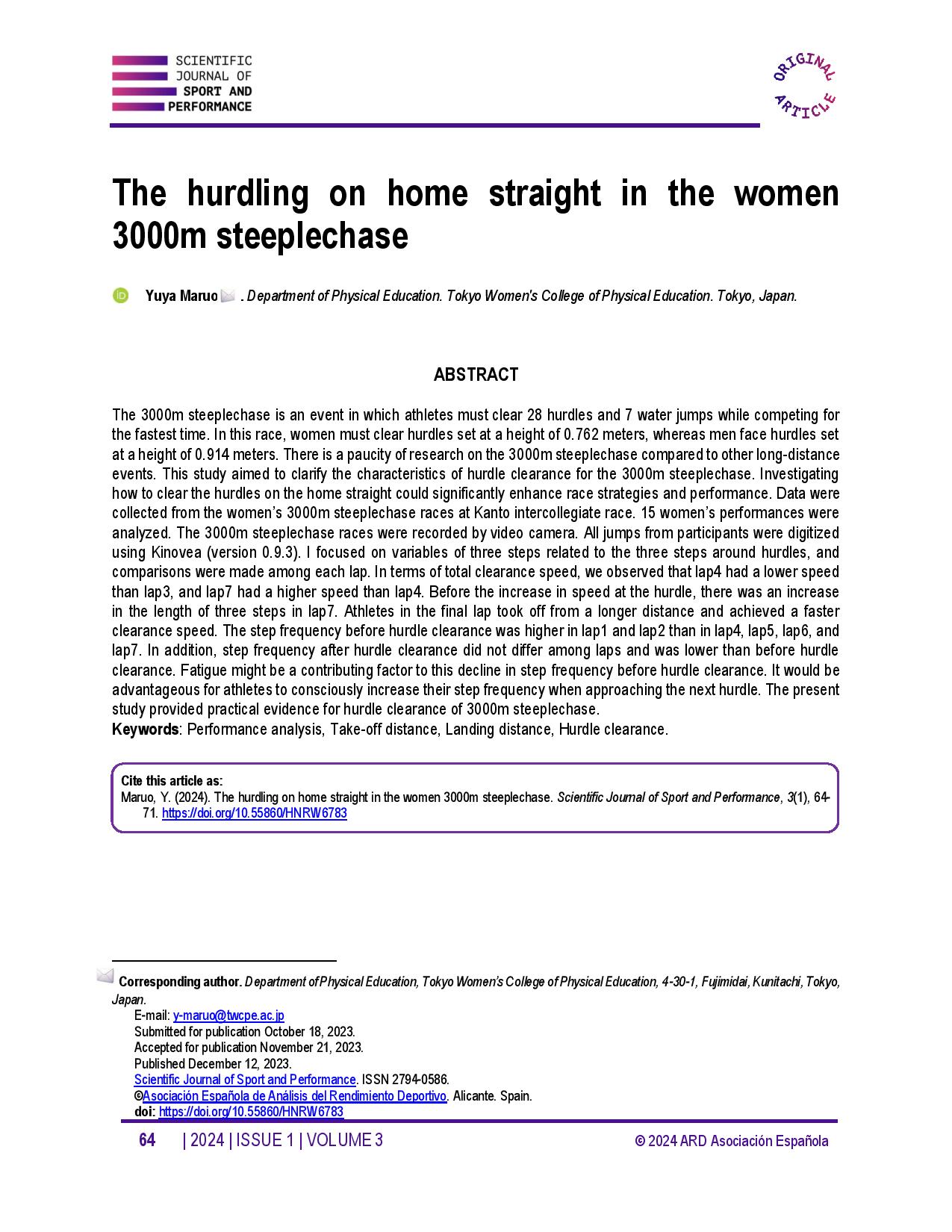The hurdling on home straight in the women 3000m steeplechase
Main Article Content
Abstract
The 3000m steeplechase is an event in which athletes must clear 28 hurdles and 7 water jumps while competing for the fastest time. In this race, women must clear hurdles set at a height of 0.762 meters, whereas men face hurdles set at a height of 0.914 meters. There is a paucity of research on the 3000m steeplechase compared to other long-distance events. This study aimed to clarify the characteristics of hurdle clearance for the 3000m steeplechase. Investigating how to clear the hurdles on the home straight could significantly enhance race strategies and performance. Data were collected from the women’s 3000m steeplechase races at Kanto intercollegiate race. 15 women’s performances were analyzed. The 3000m steeplechase races were recorded by video camera. All jumps from participants were digitized using Kinovea (version 0.9.3). I focused on variables of three steps related to the three steps around hurdles, and comparisons were made among each lap. In terms of total clearance speed, we observed that lap 4 had a lower speed than lap 3, and lap 7 had a higher speed than lap 4. Before the increase in speed at the hurdle, there was an increase in the length of three steps in lap 7. Athletes in the final lap took off from a longer distance and achieved a faster clearance speed. The step frequency before hurdle clearance was higher in lap1 and lap2 than in lap4, lap5, lap6, and lap7. In addition, step frequency after hurdle clearance did not differ among laps and was lower than before hurdle clearance. Fatigue might be a contributing factor to this decline in step frequency before hurdle clearance. It would be advantageous for athletes to consciously increase their step frequency when approaching the next hurdle. The present study provided practical evidence for hurdle clearance of 3000m steeplechase.
Article Details

This work is licensed under a Creative Commons Attribution-NonCommercial-ShareAlike 4.0 International License.
References
Aragón, S., Lapresa, D., Arana, J., Anguera, M. T., & Garzón, B. (2016). Tactical behaviour of winning athletes in major championship 1500-m and 5000-m track finals. European Journal of Sport Science, 16(3), 279-286. https://doi.org/10.1080/17461391.2015.1009494 DOI: https://doi.org/10.1080/17461391.2015.1009494
Earl, S., Hunter, I., Mack, G. W., & Seeley, M. (2015). The relationship between steeplechase hurdle economy, mechanics, and performance. Journal of Sport and Health Science, 4(4), 353-356. https://doi.org/10.1016/j.jshs.2015.03.009 DOI: https://doi.org/10.1016/j.jshs.2015.03.009
Gabrielli, E., Fulle, S., Fanò-Illic, G., & Pietrangelo, T. (2015). Analysis of training load and competition during the PhD course of a 3000-m steeplechase female master athlete: an autobiography. European Journal of Translational Myology, 25(3). https://doi.org/10.4081/ejtm.2015.5184 DOI: https://doi.org/10.4081/ejtm.2015.5184
Hanley, B., Bissas, A., & Merlino, S. (2020). Better water jump clearances were differentiated by longer landing distances in the 2017 IAAF World Championship 3000 m steeplechase finals. Journal of Sports Sciences, 38(3), 330-335. https://doi.org/10.1080/02640414.2019.1698091 DOI: https://doi.org/10.1080/02640414.2019.1698091
Hanley, B., & Williams, E. L. (2020). Successful pacing profiles of olympic men and women 3,000 m steeplechasers. Frontiers in Sports and Active Living, 2, 21. https://doi.org/10.3389/fspor.2020.00021 DOI: https://doi.org/10.3389/fspor.2020.00021
Hunter, I., & Bushnell, T. D. (2006). Steeplechase barriers affect women less than men. Journal of Sports Science & Medicine, 5(2), 318.
Hunter, I., Lindsay, B. K., & Andersen, K. R. (2008). Gender differences and biomechanics in the 3000m steeplechase water jump. Journal of sports science & medicine, 7(2), 218-222.
Inzlicht, M., & Marcora, S. M. (2016). The central governor model of exercise regulation teaches us precious little about the nature of mental fatigue and self-control failure. Frontiers in psychology, 7, 656. https://doi.org/10.3389/fpsyg.2016.00656 DOI: https://doi.org/10.3389/fpsyg.2016.00656
Maruo, Y. (2023). Characteristics of water jump for better performance in collegiate male 3000 m steeplechase. PeerJ, 11, e15918. https://doi.org/10.7717/peerj.15918 DOI: https://doi.org/10.7717/peerj.15918
Noakes, T. D., Lambert, M. I., & Hauman, R. (2009). Which lap is the slowest? An analysis of 32 world mile record performances. British Journal of Sports Medicine, 43(10), 760-764. https://doi.org/10.1136/bjsm.2008.046763 DOI: https://doi.org/10.1136/bjsm.2008.046763
Noakes, T. D., Peltonen, J. E., & Rusko, H. K. (2001). Evidence that a central governor regulates exercise performance during acute hypoxia and hyperoxia. Journal of Experimental Biology, 204(18), 3225-3234. https://doi.org/10.1242/jeb.204.18.3225 DOI: https://doi.org/10.1242/jeb.204.18.3225
Kipp, S., Taboga, P., & Kram, R. (2017). Ground reaction forces during steeplechase hurdling and waterjumps. Sports biomechanics, 16(2), 152-165. https://doi.org/10.1080/14763141.2016.1212917 DOI: https://doi.org/10.1080/14763141.2016.1212917
Kirby, B. S., Winn, B. J., Wilkins, B. W., & Jones, A. M. (2021). Interaction of exercise bioenergetics with pacing behavior predicts track distance running performance. Journal of Applied Physiology, 131(5), 1532-1542. https://doi.org/10.1152/japplphysiol.00223.2021 DOI: https://doi.org/10.1152/japplphysiol.00223.2021
St Clair Gibson, A., & Noakes, T. D. (2004). Evidence for complex system integration and dynamic neural regulation of skeletal muscle recruitment during exercise in humans. British journal of sports medicine, 38(6), 797-806. https://doi.org/10.1136/bjsm.2003.009852 DOI: https://doi.org/10.1136/bjsm.2003.009852
Tucker, R., Lambert, M. I., & Noakes, T. D. (2006). An analysis of pacing strategies during men's world-record performances in track athletics. International journal of sports physiology and performance, 1(3), 233-245. https://doi.org/10.1123/ijspp.1.3.233 DOI: https://doi.org/10.1123/ijspp.1.3.233
Weir, J. P., Beck, T. W., Cramer, J. T., & Housh, T. J. (2006). Is fatigue all in your head? A critical review of the central governor model. British Journal of Sports Medicine, 40(7), 573-586. https://doi.org/10.1136/bjsm.2005.023028 DOI: https://doi.org/10.1136/bjsm.2005.023028




